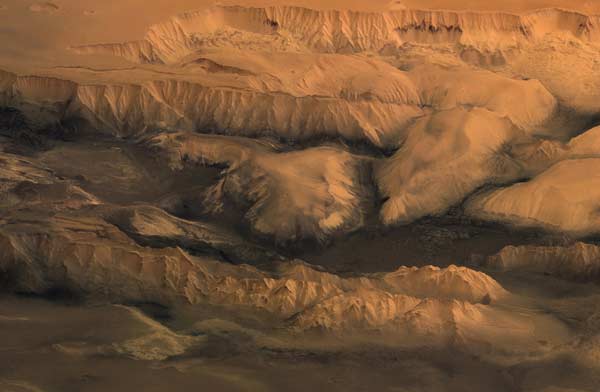[/caption]
We’ve known about the methane in Mars’ atmosphere for over four years now. But we don’t know where it is coming from. On Earth, methane is produced from biological agents: rotting vegetation or flatulence from large animals like cows. But, of course, with our extensive explorations of Mars with rovers and high-resolution orbiting cameras, we’re fairly sure there are no Martian bovine equivalents chewing cud from the foliage on the Red Planet. Even if life existed in the past on Mars, methane is broken down quite quickly by sunlight, and scientists have calculated that methane should only exist for a few hundred years in the Martian atmosphere. The only possibility is that somehow, either chemically or biologically, the methane is being replaced on a regular basis. And now, two recent reports outlining separate discoveries on Mars make this methane mystery even more intriguing.
Methane was discovered on Mars by three independent groups in 2003 – 2004. One detection was made using the Mars Express spacecraft, another used observations from the Keck II and Gemini South telescopes, and the third used the Canada-France-Hawaii telescope.
And the mystery of how methane on Mars is being replenished has scientists continuing their observations in an effort to understand what’s happening on Mars. Michael Mumma of NASA’s Goddard Space Flight Center in Greenbelt, Maryland was one of the original methane discoverers. Observations he and his team have made over the last four years show methane is not spread evenly around Mars, but concentrated in a few “hotspots.” They have seen that methane clouds spanning hundreds of kilometers form over these hotspots and dissipate within a year – much shorter than the 300 – 600 years it was thought to take for atmospheric methane to be destroyed by sunlight. If methane is being destroyed so quickly, it also must be created at far higher rates than previously thought. Mumma reported these results at a planetary science conference last month.

One of the hotspots is Nili Fossae a fissure that has been eroded and partly filled in by sediments and clay-rich ejecta from a nearby crater. Could a living ecosystem be hidden here under the Martian surface? On Earth, subterranean microbes survive without sunlight, free oxygen, or contact with the surface. Additionally, the prospect becomes more intriguing when it is known on Earth, most deep-surface microbes are primitive, single-celled organisms that power their metabolism with chemical energy from their environment. These microbes are called “methanogens” because they make methane as a waste product.
Nili Fossae is one of the possible landing sites for the Mars Science Laboratory, the next generation of rover currently set to head off the Red Planet next year.

But astrobiologists aren’t ruling out the possibility of some type of ongoing chemical process on Mars, which could be producing the methane. But even this is intriguing, because it means there are active processes going on inside Mars. One idea proposed in a recent paper is that methane clathrates are near the Martian surface, and are constantly releasing small amounts of methane as temperatures and pressure near the surface change.
Methane clathrates are solid forms of water that contain a large amount of methane within its crystal structure.
Caroline Thomas and her colleagues at the Universite de Franche-Comte say the clathrates could only exist near the surface of Mars if the atmosphere had once been methane rich. Otherwise the clathrates could never have formed. One possibility is that the atmosphere was once temporarily enriched by a comet impact. Also, the discovery of gray crystalline hematite deposits on the surface could be a proof of an early methane-rich Martian atmosphere.
Otherwise, the researchers say, the only other possibility is a biological source.
“Our results show that methane enriched clathrate hydrates could be stable in the subsurface of Mars only if a primitive CH4-rich atmosphere has existed or if a subsurface source of CH4 has been (or is still) present,” the researchers write.
So what does all this mean? The Mars Science Laboratory rover might have the ability to find out, or at least bring us closer to solving this mystery. Otherwise it will take a fairly large breakthrough from the other spacecraft and telescopes observing Mars. But it’s possible we might not fully understand why Mars has methane until humans actually go there themselves to find out.
Sources: arXiv, arXiv blog, New Scientist, Nature


So isn’t this tentative proof of life down there….??!! I hope it’s something totally unlike what we have on earth so that if we ever get to it… it will show us what other forms of life are possible in the universe/solar system!!
Although I have to admit I think it’s probably a volcano/non living source…
So isn’t this tentative proof of life down there….??!!
Not really – Titan has ENORMOUS quantities of methane, and that’s probably not biological – it’s too cold.
Isn’t there also methane on Titan, Uranus, Neptune, etc? But suggestions of life on Neptune are few and far between. Is methane less prone to breakdown in the outer solar system? I’m guessing the sunlight is not intense enough?
Kevin F.
(Titan is) “too cold.”
Not exactly. Pehaps at a certan depth under the surface (where its slightly warmer) there are cryogenic lifeforms.
http://discovermagazine.com/2008/feb/did-life-evolve-in-ice
Nili Fossae for the win
“Is methane less prone to breakdown in the outer solar system? I’m guessing the sunlight is not intense enough?”
Yep. Inverse square law and all that – the sunlight is far less intense out there so far less methane photo dissociation occurs.
Plus, we expect to find methane in the outer solar system in relative abundance in comparison to the inner solar system purely due to the manner in which the solar system formed. Since it is a volatile and photo-dissociates easily, the only place in the solar system where it is relatively stable and could form in abundance is the outer solar system far from the Sun, which is why we tend to see it in the outer planets and their moons and not so much on the inner planets…
Not exactly. Pehaps at a certan depth under the surface (where its slightly warmer) there are cryogenic lifeforms.
True, dat. 🙂
Thanks!
[i]Plus, we expect to find methane in the outer solar system in relative abundance in comparison to the inner solar system purely due to the manner in which the solar system formed. Since it is a volatile and photo-dissociates easily, the only place in the solar system where it is relatively stable and could form in abundance is the outer solar system far from the Sun…[/i]
So did the outer solar system’s methane all come from the pre-system nebula, and it just never broke down? Or is it still being formed out there?
Isn’t it all funny?
Imagine Aliens from different solar system detecting methane on Earth. Logical mind would assume the most probable scenario first: there is life on planet Earth.
Only strange and narrow minded Aliens would be looking at other possibilities FIRST (regardless of how impossible): never seen before chemical reactions, strange explanations etc.
Get it straight: methane on Mars is produced by living organisms, like on Earth as it is the simplest explanation.
“Get it straight: methane on Mars is produced by living organisms, like on Earth as it is the simplest explanation.”
That may be the simplest explanation, but to work under the assumption that it’s true wouldn’t be good science. Remember, the simplest explanation was once “the earth must be flat, or we’d roll off the edge.”
I’d bet a nice cold Schmidt beer that it’s little tiny bacterial creatures at Nil Fossae giving off some of the methane.
Could Mars Science Laboratory give us a definitive answer on that?
My bet would be that there are some organisms down there, probably similar to the water bear. Most likely the biosphere would be highly season and far from thriving.
The really interesting question though is what conditions are required for the genesis of such organsims.
Drill there, drill now! A new rationale for going to Mars!
It’s also silly to think that NASA is still looking for life on Mars. They have known for ages there is life thriving on that planet.
Besides, what’s so hard in sending some hi-tech equipment that was not available in Vikings era (although 2 out of 3 viking experiments in search of extraterrestial life were POSITIVE), so it can easily detect bacteria?
It’s not hard at all and it’s so obvious that NASA sent some undisclosed equipment to Mars to perform some classified experiments.
“They have known for ages there is life thriving on that planet.”
That is simply bollocks
Meera,
Would that we should know all as thou.
I humble myself in thy presence.
I’m betting non organic origins. I don’t think that Mars supports life at all. Life, at least here, has a way of getting around. If it’s there, it’s everywhere! If life were so ubiquitous as to be on TWO of our planets, then don’t you think there would have been some intelligent life out there somewhere not too distant that we would know about by now?
Perhaps life is common but intelligent life is not
I have tertiary syphilis.
Have people ever thought that they might be living in the ground like some sort of moles? I mean, they aren’t exactly like us. And that could be a possiblity. Like deep down in the dirt. And they live down there instead of on the surface. Have people ever actually like dug holes, deep holes, in Mars anyways?
Careful. Sir Thomas Gold speaks of huge amount of methane deep within the Earth’s mantle of geologic origin – so much more than than all of the oil and gas that exists from biology. Mars could have a source like that.
Vanamonde has it more right than anyone else so far. May i add some things ?
Neptune is uniformly blue precisely because it is all covered in liquid methane.
No land masses and at about -220C.
For a moon of Saturn, Titan, lakes of the stuff, enough to supply earth indefinitely, in a manner of speaking only as it would likely kill us.
So, what we also have on Earth and Mars is of the same origin – when the Solar System formed 4.7Bn yrs ago, and that’s it !
One can talk about microbial life forms causing it but they themselves are carbon based and so obtained the carbon from the pre existing methane.
Notice how the article is in unspoken dread of the idea getting around that the presence of methane on Mars will kill once and for all the politically correct notion that the methane gas we have here is fossil in origin.
The correct understanding that all this methane is really abiotic in origin will expose the hoax that is carbon taxes, for as the supply of abiotic methane gas on Earth is unlimited simply because it is not fossil in origin what then is the justification for carbon taxes – please ?
Neptune’s methane is uniformly spread around the planet whereas Mars methane seems concentrated in certain areas only to dissipate then reappear later. The most likely explanation is living organisms. Why don’t scientists simply say that rather than looking for a more unlikely explanation?